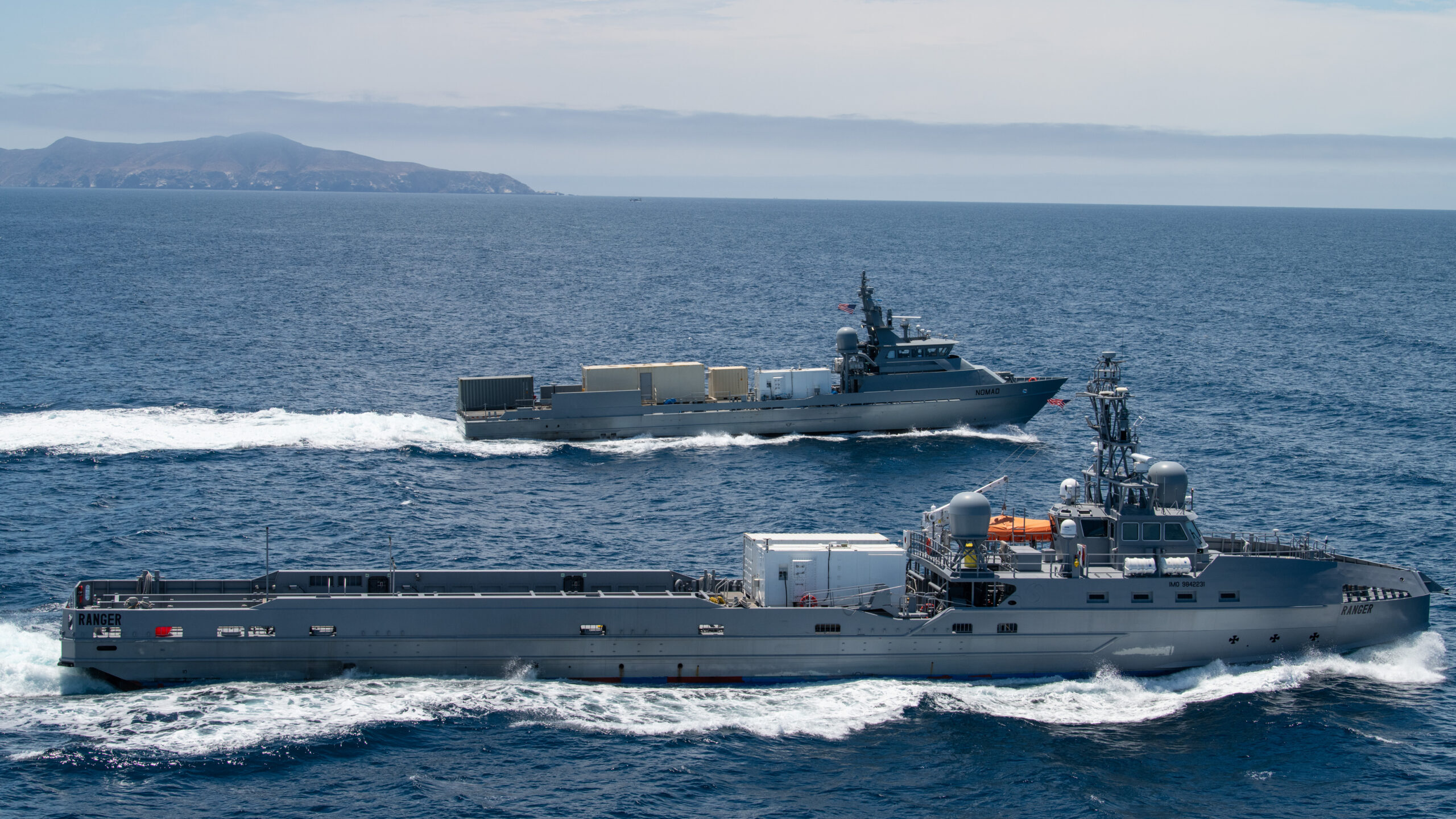
Aerial photos of USS Ranger and USS Nomad unmanned vessels underway in the Pacific Ocean near the Channel Islands on July 3, 2021. (U.S. Navy photo by Eric Parsons)
WASHINGTON: The Navy’s engineers guiding the service’s future unmanned surface vessels say this year’s RIMPAC has shown that, unlike some in Washington, the fleet is less concerned about the autonomy software driving the new tech and focused more on what missions it can help sailors achieve.
“One of the biggest [pieces of] feedback we’re getting is that they’re talking about payloads, they’re talking about capabilities,” said Brian Fitzpatrick, a Navy official in the service’s program office for unmanned maritime systems. “They’re not talking about the autonomy… They’re not worried that [the USV is] going to ever run into something.”
The six-week, multi-national Rim of the Pacific exercise wraps up this week, during which four high profile unmanned surface vessels — known as Sea Hunter, Sea Hawk, Nomad and Ranger — all spent time operating with the fleet alongside US destroyers and other traditional, manned warships.
Fitzpatrick and other Navy officials told a small group of reporters Monday that they are still collecting and analyzing data from the USVs’ operations — including about one test hiccup — but what they value more than raw data is what sailors had to say about getting hands on with the technology.
The officials didn’t address exactly how effective the unmanned vessels were in aiding the exercise, but one of the takeaways, they said, is that despite varying levels of concern here in Washington about the prospect of a US Navy drone sailing autonomously near other, sometimes foreign ships, sailors had little to say about the vessels’ obedience to different commands. Rather, the sailors moved straight to requests, like the ability to control different USVs from the same console.
“That’s one of the biggest [pieces of] feedback — they want to take Sea Hunter and an Overlord, which were developed under two different programs and have two different [communications] suites… to be controlled [through] the same platform,” he said. “Overlord” refers to Project Overlord, the Strategic Capabilities Office program under which the USVs Nomad and Ranger were built.
Separate from getting input from sailors, major exercises such as RIMPAC also give program officials an opportunity to show the fruits of their labor to senior brass, such as chief of naval operations Adm. Michael Gilday.
Gilday has envisioned a hybrid fleet where manned ships sail alongside unmanned vessels, but in April, prior to the exercise, Gilday cast doubt about the place certain drones such as the Medium Unmanned Surface Vessel would have in the future. The admiral attended parts of RIMPAC, but hasn’t said yet whether the autonomous vessels’ performance has changed his mind.
Rear Adm. Casey Moton, a senior Navy officer overseeing unmanned maritime vessel programs, told reporters the feedback and data gathered from RIMPAC will “inform” the service’s decisions about how to proceed with its MUSV program of record, adding that CNO’s prior comments were part of a “healthy conversation.”
During the Monday call with reporters, the Navy officials also revealed there had been at least a slight hiccup with one of the four USVs during RIMPAC. Fitzpatrick said one of the USVs — without specifying which one — was suppose to swap control from an off-site operations center to one of the destroyers sailing alongside the USV. For reasons the officials declined to explain, that swap had to be called off due to an issue with the destroyer. Fitzpatrick said the unexpected mishap was representative of issues the service will have to contend with regularly if it intends to build the hybrid fleet.
“We were able to just immediately switch back to the [unmanned operations center] in San Diego,” Fitzpatrick said. “That was part of the roadmap that led up to this… We need to be able to switch between controlling platforms.”
GD chief says Navy’s 1 sub buy won’t impact company short term, but out years less certain
The comments from the General Dynamics chief come on the same day President Joe Biden signed the national security supplemental, which includes billions for the sub industrial base.



























